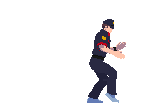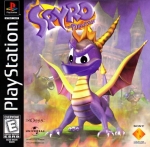
I have interesting history with the Spyro series. My first exposure to it was the demo of the first game included with Crash Bandicoot: Warped, its inclusion owed to the fact that Naughty Dog and Insomniac had a working relationship. Years later I found myself in a video rental store picking out a game to rent. Spyro 2 caught my eye, and I rented it, played it, and really enjoyed it. Spyro 2 is definitely my favorite of the series, and the one I would recommend overall. However, recently I saw a 100% speed-run race of the original Spyro the Dragon, so I was reminded that I have never completed any of the Spyro games to 100% completion. Inspired, I chose to finish the original.
The story of Spyro isn't very much of a surprise, for a game largely meant for kids. Gnasty Gnorc (pronounced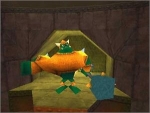 with silent G's) is your average thick-headed bad guy. A dragon in a news cast in the opening calls him ugly, so he turns all the dragons to stone and unleashes and army of gnorcs created out of treasure. Spyro, a young dragon, must now free all the dragons, collect treasure, and stop Gnasty Gnorc. The story is serviceable, but you'll never really feel any tension. The game contains bosses (presumably higher ranking gnorc henchmen), but there's no buildup to them at all, and most of them are pretty easy to beat. The game contains voice acting, and it's all performed really well. I'm not a huge fan of Carlos Alazraqui's voice for Spyro, but it never gets too annoying. The rest of the dragons often give you fully voiced advice, though some often offer the same advice, due to the game's not-so-linear nature. Comedy is attempted, but often falls flat. For instance, multiple times Spyro is confronted with and old dragon that begins to tell a story from his youth. Cue Spyro saying something like "gotta go!" The humor doesn't really detract from the game overall, though.
with silent G's) is your average thick-headed bad guy. A dragon in a news cast in the opening calls him ugly, so he turns all the dragons to stone and unleashes and army of gnorcs created out of treasure. Spyro, a young dragon, must now free all the dragons, collect treasure, and stop Gnasty Gnorc. The story is serviceable, but you'll never really feel any tension. The game contains bosses (presumably higher ranking gnorc henchmen), but there's no buildup to them at all, and most of them are pretty easy to beat. The game contains voice acting, and it's all performed really well. I'm not a huge fan of Carlos Alazraqui's voice for Spyro, but it never gets too annoying. The rest of the dragons often give you fully voiced advice, though some often offer the same advice, due to the game's not-so-linear nature. Comedy is attempted, but often falls flat. For instance, multiple times Spyro is confronted with and old dragon that begins to tell a story from his youth. Cue Spyro saying something like "gotta go!" The humor doesn't really detract from the game overall, though.
In contrast to the Crash Bandicoot games, which were largely linear affairs inspired by the likes of Donkey Kong Country (but in  three dimensions), Spyro follows more in the lead of Mario 64, and presents more of a sandbox. That is, levels do not simply go from point A to point B, but allow for more freedom of movement throughout. Much like Nintendo's plumber in 3D, the game is split between hub worlds (which act more like levels in themselves in Spyro) and the actual levels, accessed through portals in the hub. In hindsight, these sorts of games are often called "collect-a-thons", due to their emphasis on exploration and collecting items in its levels. Indeed, in order to progress to the next "realm" (hub level), you must collect enough of some object (different for each realm) in order for the balloonist to take you to the next. This arrangement is perfectly workable, but can get a bit tedious, having to travel back and forth to get to the level you need to find items in. Made even worse, is the fact that the hubs have enemies in them that respawn once you re-enter them. This was fixed in the sequel. If you are a completionist, you may enjoy this game, as it offers a post-game reward for finding everything.
three dimensions), Spyro follows more in the lead of Mario 64, and presents more of a sandbox. That is, levels do not simply go from point A to point B, but allow for more freedom of movement throughout. Much like Nintendo's plumber in 3D, the game is split between hub worlds (which act more like levels in themselves in Spyro) and the actual levels, accessed through portals in the hub. In hindsight, these sorts of games are often called "collect-a-thons", due to their emphasis on exploration and collecting items in its levels. Indeed, in order to progress to the next "realm" (hub level), you must collect enough of some object (different for each realm) in order for the balloonist to take you to the next. This arrangement is perfectly workable, but can get a bit tedious, having to travel back and forth to get to the level you need to find items in. Made even worse, is the fact that the hubs have enemies in them that respawn once you re-enter them. This was fixed in the sequel. If you are a completionist, you may enjoy this game, as it offers a post-game reward for finding everything.
Spyro has three main abilities: Gliding, flame breath, and charging. Gliding is an interesting mechanic that leads to some really interesting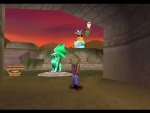 level exploration. Flame breath is a standard attack, but doesn't work on enemies that wear metal, who need to be charged with Spyro's horns. Charging involves holding the square button which makes Spyro charge forwards and hit enemies with his horns. Charging, however, does not work on large enemies. So there's an interesting attack balance going on, where certain enemies require certain attacks. After a while, though, it can begin to feel like you're going through the motions with enemies. Things can get pretty challenging when they throw metal-wearing enemies and large enemies into the same room together. The enemies are actually pretty well animated for an original Playstation game. Enemies often actually react to you, some even going so far as to moon you.
level exploration. Flame breath is a standard attack, but doesn't work on enemies that wear metal, who need to be charged with Spyro's horns. Charging involves holding the square button which makes Spyro charge forwards and hit enemies with his horns. Charging, however, does not work on large enemies. So there's an interesting attack balance going on, where certain enemies require certain attacks. After a while, though, it can begin to feel like you're going through the motions with enemies. Things can get pretty challenging when they throw metal-wearing enemies and large enemies into the same room together. The enemies are actually pretty well animated for an original Playstation game. Enemies often actually react to you, some even going so far as to moon you.
The game contains many gimmicks to vary up the gameplay. One of the often used ones is the supercharge strip. It's a patch of ground with arrows on it that speeds you up and makes you invincible while you run. I can see why they used it so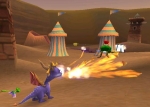 much, since there's lots of interesting things you can do with this. If you jump after a charge you gain incredible height, allowing for exploration. You can even chain multiple supercharge pads together to get even more height. Some of the secrets that require this can get pretty cryptic, though. There are also stages where you fly the entire time, and the present a very arcade style gameplay. You have to fly around the stage and destroy all the objects (usually things like chests, trains, airplanes, or flying through crystal arches) before the time runs out. They require learning the order that you should take to get the best time. These can be really fun, but also really challenging.
much, since there's lots of interesting things you can do with this. If you jump after a charge you gain incredible height, allowing for exploration. You can even chain multiple supercharge pads together to get even more height. Some of the secrets that require this can get pretty cryptic, though. There are also stages where you fly the entire time, and the present a very arcade style gameplay. You have to fly around the stage and destroy all the objects (usually things like chests, trains, airplanes, or flying through crystal arches) before the time runs out. They require learning the order that you should take to get the best time. These can be really fun, but also really challenging.
Overall, I'd still highly recommend Spyro the Dragon, especially to those with kids or people who just love 3D platformer games. Granted, this game does have some "early installment weirdness" going for it, but it's nothing too bad. The sequel is improved, but this one is still really solid.


